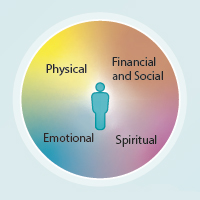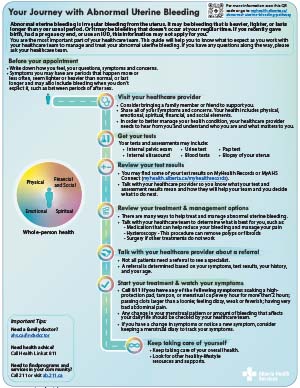This guide will help you know what to expect as you work with your healthcare team to manage and treat abnormal uterine bleeding. Note that if you recently gave birth, have had a pregnancy end, or you use an
IUD, this information may not apply to you. See your healthcare provider if you have questions about your health.
You will have your own journey with abnormal uterine bleeding. How you move through your journey, the number of visits with your healthcare team, the steps you take, and the order you take them in will depend on your needs. You will make decisions in partnership with your healthcare team. Always follow your healthcare team’s advice.
What is abnormal uterine bleeding?
Abnormal uterine bleeding is menstrual bleeding that is not normal for you.
The uterus is a hollow, pear-shaped organ in the lower abdomen. About once a month, the lining of the uterus thickens. If you do not become pregnant, your uterus sheds its lining as a menstrual period.
Bleeding that happens when you don’t expect it in your cycle or large amounts of blood during a regular cycle is abnormal uterine bleeding. If you are in menopause and not taking hormone therapy, any uterine bleeding is abnormal.
Abnormal uterine bleeding can have many causes, including:
- hormone changes
- growths in the uterus
- clotting problems
- rarely, a more serious problem such as cancer
Sometimes the cause of the bleeding isn't known.
Whole-person health
The whole-person health approach will help you and your healthcare team better manage your health condition.

Whole-person health draws from the teachings of the medicine wheel. It means thinking about all parts of your health and wellness:
- physical
- financial and social
- emotional
- spiritual
These parts are all connected and impact each other. It’s important to be aware of your personal needs in each part and to share that information with your healthcare team. Your healthcare team needs to understand who you are and what matters to you.
Support and resources
- If you need a family doctor, visit Alberta Health Services:
Find a doctor.
- If you need a translator, let your healthcare provider know.
- If you need health advice any time, day or night, call Health Link at 811.
- If you need to find programs and services in your community, call or text 211 or visit
211 Alberta.

Abnormal Uterine Bleeding Pathway
Download or print the
full patient pathway (PDF) and
summary (one-page PDF) to learn more about how to manage and treat abnormal uterine bleeding.
Patient Pathway  Summary
Summary 
